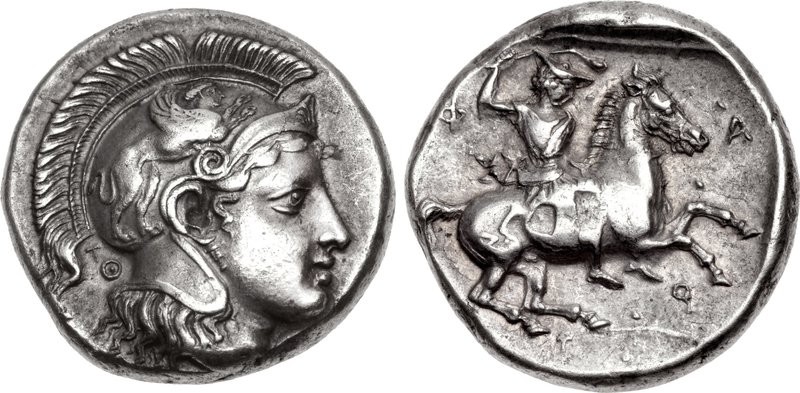3162 - Pharsalus (drachma Athena/horseman) over uncertain type (CNG, 26, June 1993, 278)
From SILVER
400 BCE - 370 BCE | ΦΑΡΣ
Images
Overstriking coin

CNG_199.jpg [1]
Location/history
| Sale(s)Sale(s) ᵖ: | Historical Coin Review, XIV/6, 11 Dec. 1989, n°30 = Classical Numismatic Auctions,11, 03 May 1990, 55 = Classical Numismatic Group, 26, 11 June 1993, 278 = Triton XVII, 01 Jan. 2014, 199 | |
| Private collection(s)Private collection(s) ᵖ: | R. A. J. Collection |
Overstriking coin
Description
| ObverseInscription or printing placed on the obverse.: | Head of Athena right, wearing crested Attic helmet, decorated with sphinx leaping right, and single-pendant earring. Behind neck guard, TΘ. | ReverseInscription or printing placed on the reverse.: | ΦΑΡΣ (Greek) Thessalian horseman charging right, wearing petasos, brandishing lagobolon. |
Mint and issuing power
| MintIdentifies the place of manufacture or issue of a numismatic object.: | Pharsalus | Ancient regionAncient region. | Thessaly | Modern countryModern country: Greece | AuthorityIdentifies the issuing power. The authority can be "pretended" when the name or the portrait of X is on the coin but he/she was not the issuing power. It can also be "uncertain" when there is no mention of X on the coin but he/she was the issuing power according to the historical sources: |
Chronology
| FromIdentifies the initial date in a range assigned in a numismatic context. 400 BCE toIdentifies the final date in a range assigned in a numismatic context.. 370 BCE | Classical 480-323 BC |
Physical description
| MetalThe physical material (usually metal) from which an object is made.: Silver |
WeightWeight of the numismatic object (in grams). in grams: 6.16.1 g <br />6,100 mg <br /> | DenominationTerm indicating the value of a numismatic object. Examples: tetradrachm, chalkous, denarius.: drachma |
AxisDescribes the directional relationship between the obverse and reverse of a numismatic object.: 88 mm <br />0.8 cm <br /> |
| DiameterDescribes diameter of an object (in mm).: 1818 mm <br />1.8 cm <br /> | StandardStandard.: Aeginetic | ||
References
| Coin referenceReference of the Coin: | Lavva 2001, n°144c corr. (V68/R84). | Coin series referenceReference to coin series study: | Lavva 20011Lavva 2001, n°163, HGC 42HGC 4, n°626 |
| Coin series web referenceCoin series web references: | |||
Overstruck type
Description
| ObverseInscription or printing placed on the obverse.: | ReverseInscription or printing placed on the reverse.: |
Mint and issuing power
| MintIdentifies the place of manufacture or issue of a numismatic object. ᵖ: | Ancient regionAncient region. ᵖ | Modern countryModern country: | AuthorityIdentifies the authority in whose name (explicitly or implicitly) a numismatic object was issued. ᵖ: |
Chronology
| FromIdentifies the initial date in a range assigned in a numismatic context. toIdentifies the final date in a range assigned in a numismatic context.. | periodTime period of the numismatic object. |
Physical description
References
| Coin type referenceReference to coin series study ᵖ: |
Additional data
| Frequency of overstrikesFrequency of overstrikes: | exceptional | Level of confidenceLevel of confidence of the identification: | strong |
| RemarksRemarks: | "overstruck on uncertain type (portions visible on horse)" | ||
References
- ^ Lavva, Stella (2001), Die Münzprägung von Pharsalos, Saarbrücken, 254 p., 29 pl.
- ^ Hoover, Oliver D. (2014), Handbook of Greek Coinage Series 4. Northern and Central Greece : Achaia Phthiotis, Ainis, Magnesia, Malis, Oita, Perrhaibia, Thessaly, Akarnania, Aitolia, Lokris, Phokis, Boiotia, Euboia, Attica, Megaris and Corinthia, sixth to first centuries BC, Lancaster, lxxi, 563 p.